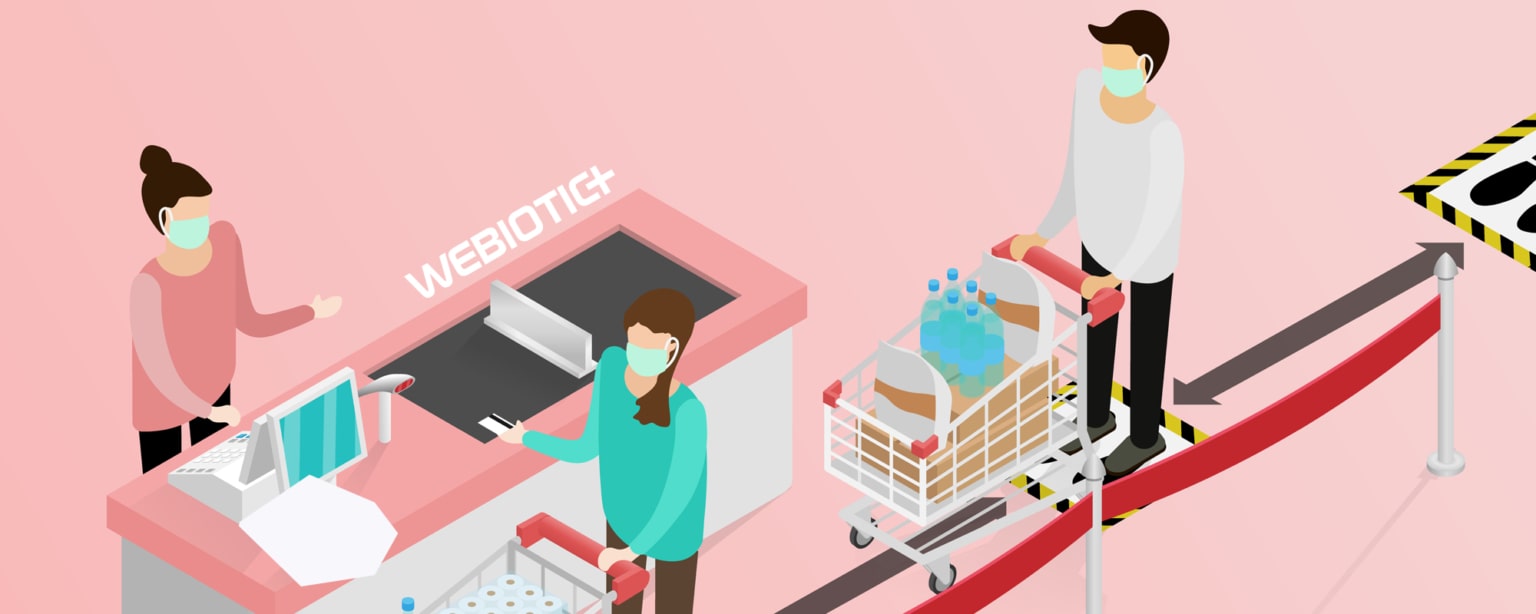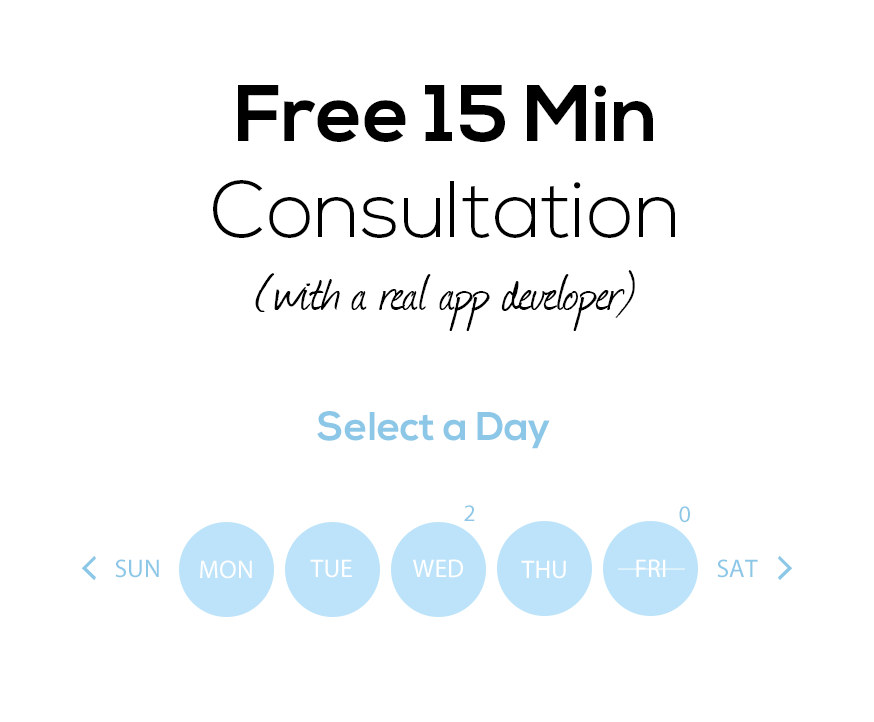Updated
14 min read
The Ultimate Guide for COVID-19 Mobile Apps

The pandemic has had a major impact on the way we live and work, which hasn’t been easy. So it’s no surprise that we’re turning to technology with the hopes that it can help improve our lives.
From digital contact tracing apps to new delivery service apps, Covid has inspired technologists and entrepreneurs around the world to build more mobile applications that respond to people’s wants and needs.
And why wouldn’t they?
The mobile market is growing substantially every year, pandemic or not, and new apps have the ability to generate considerable profits. In fact, mobile apps are projected to generate more than $935 billion in revenue by 2023.
If you have an app idea that you’re ready to build and capitalize on, now is an exciting time to get started.
I dive into how businesses can thrive during the pandemic in this video.
Now let’s take a look at popular COVID-19 apps to get you feeling inspired, industries that are brimming with potential, and what to consider before rolling up your sleeves.
Let’s take a look!
Top COVID-19 Apps
If you want your app to be successful, the first step is to know your competition.
What other COVID-19-related apps are out there? What are they doing right? And what can you learn from those apps when building your own?
Let’s take a look at a few popular apps that are helping people get through these tough times, whether it’s through entertainment, like group video apps or through understanding the virus statistics, like COVID-19 tracing apps.
World Health Organisation (WHO)
The WHO app is one of the best in providing the latest in Coronavirus health information along with advice, tips in social distancing, and the latest news.
Mobile app users can stream live WHO conferences through the app.
TraceTogether
This is a contact tracing app created specifically for COVID-19 and works through the use of Bluetooth technology to help users reduce the spread of the virus.
If you’ve been in close contact with someone who has the virus, the app allows the Ministry of Health to get in touch with you and give advice on the next steps.
Zoom
The Zoom app has been around well before the virus came marching in, but it’s emerged as the top app for video conferencing and screen sharing calls with friends, family, and coworkers.
The app went from 200 million users in March of this year (2020) to 300 million in April.
Headspace
Headspace is another app that’s been around longer than the virus but it’s reached widespread appeal as more people are looking for ways to manage their anxiety, sleep, and soothe their minds.
It’s a mindfulness app with chock-full of great features, like guided meditations, SOS sessions for moments of panic and anxiety, and so much more that can and has helped people stay calm during the pandemic.
Their mission of improving health and happiness shows in their numbers.
65 million people have downloaded the app and over 600 companies are offering Headspace to their employees.
Houseparty
Houseparty offers an alternative to the face-to-face interactions with friends and family we’re used to in this time of social distancing.
The app serves as a social network where you can connect through video chats and play games through the app. It also alerts you when your friends are using the app so you can connect instantly.
Google and Apple Partnership
While things are still in production, Google and Apple announced back in April of this year their plans for partnering up to roll out a series of contact tracing apps using a public API.
The goal is to let people use their Apple or Android device to receive notifications if they’re near someone who has been exposed to or is diagnosed with COVID-19.
While people are wary about how their privacy will stay protected when using a tracking app like this, there’s no doubt that this could be a very powerful public health defense tool that can benefit millions of people around the world.
This is just the tip of the iceberg!
There are tons of apps out there that have either emerged from the pandemic or have surged in popularity because of it.
Covid-19 Apps in Your Industry
As you can see from the previous section, there’s plenty of opportunity for Covid-related apps in virtually every industry.
If you have a Covid-19 app idea, chances are, it can bring real value to people during these unprecedented times.
Opportunity #1: Covid Apps in the Health Industry
There’s a lot of misinformation related to the virus and so health apps are beginning to take up a good chunk of real estate in app stores.
Some are simply informative and offer up helpful resources, like preventative measures and new research discovered, and others offer more specialized features, like contact tracing.
You can’t put a price on health, and so health apps like these have a ton of potential.
Opportunity #2: Covid Apps in the Delivery Services Industry
If you enjoyed eating out as much as me pre-COVID-19, then you know how much delivery app services are thriving right now.
People want the comfort foods they’re used to enjoying, but now delivered to their door instead of at a crowded restaurant.
But it’s not just restaurant deliveries, right? There are apps catering to delivering groceries, clothing, and even medical prescriptions.
These apps are partnering with businesses and earning revenue by offering us something that’s never been more valuable: safe and contactless deliveries.
Opportunity #3: Covid Apps in the Education Industry
As schools are moving towards online learning, both instructors and students are leveraging learning apps and digital resources to make their lives easier.
This is a huge opportunity. These types of education-related apps are in high demand. In fact, the global online market is predicted to reach a market value of $325 billion by 2025, and this data emerged before COVID-19 hit.
Whether it’s virtual tutoring, video conferencing tools, language apps, or some other online learning software app, COVID-19 is having a significant impact on the education industry as more schools are closing.
As you can see, the number of learners impacted by school closures is rapidly increasing.
Opportunity #4: Covid Apps in the Fitness Industry
Some gyms are opening their doors and some are staying shut, but one thing remains—people just don’t feel comfortable hitting the gym amidst a global pandemic.
Fitness apps deserve our love now more than ever because they let us maintain our exercise schedule, but from home.
While I started off quarantining by throwing on some workout clothes and going for an occasional run, I’ve since explored different apps that could help me create a stricter workout regiment.
Fitness mobile apps bring incredible value to people who are just trying to have control over their physical and mental well-being in a time where we don’t feel so in control.
Opportunity #5: Covid Apps in the Entertainment Industry
Entertainment apps, like games and streaming services, have always been popular categories in app stores, but now with everyone stuck at home and looking for fun diversions, these types of apps are booming.
The best part of creating a mobile app in this industry is that there’s always an audience ready and willing to have their boredom alleviated, whether it’s with Netflix or Mario Kart Tour.
Unlike other industries that require some level of innovation or technology, like contact tracing apps, for example, the success of an entertainment app relies heavily on your own creativity.
Game apps make big profits through various revenue models, but by offering in-app purchases (IAP), like allowing users to make upgrades or buy game currencies (points, coins, gems, etc) you can quickly monetize your app.
According to Khalid Saleh of Invesp, IAP accounts for roughly 48.2% of all mobile-app earnings.
Opportunity #6: Covid Apps in the Workplace/Productivity Industry
I’ve seen such a variety of workplace and productivity apps where I think to myself, “How could this product possibly improve on what already exists?”
Apps like Slack, Zoom, and Trello take productivity to a whole new level. At face value, it’s a messaging app, a video conferencing app, and a task organization app, respectively, but once you integrate them into your workflow, well, there’s no going back.
Your app doesn’t need to be revolutionary. Sometimes it just needs to be an improvement.
As more people are working from home, myself included, apps and digital tools that can make the work life easier are invaluable.
Opportunity #7: Covid Apps in the Dating Industry
Let’s face it, life gets lonely when you’re stuck at home quarantining solo.
While our social lives have dwindled, dating apps are seeing an uptick in users and subscribers during the pandemic.
According to Business Insider, Match Group’s second quarter earnings this year have shown that more people are using online dating apps.
Match Group has over 45 dating brands, like OKCupid, Tinder, and Match, which covers over 60% of the dating app market.
Some apps are rolling out virtual dating sessions while others are sticking to swipes, texts, and phone calls.
If you have a dating app idea, now is the time to start fleshing out your app and begin development.
What to Consider for a COVID-19 Mobile App
Is your COVID-19 mobile app idea ready to go?
Let’s review a few things you should consider in the pre-development brainstorming phase.
Establish what kind of app it is
There all kinds of COVID-19 apps—some which are strictly informative, like the WHO app, some that leverage technology to help reduce the spread of the virus, like the TraceTogether app, and some that just bring value in the form of entertainment, like the Houseparty app.
Have a clear understanding of what kind of app yours is and what purpose it will serve amidst a pandemic that is driving more mobile users to download apps.
This is all part of defining the scope of your app which will bring value to the development phase.
Identify your audience
Building an app to help people get through the pandemic and building an app for public health officials and epidemiologists calls for totally different approaches.
It’s pointless to try and create a brand without knowing who you’re creating it for, right?
So if you have the idea in your head that your app is for everyone, get rid of it! Every group of people has different needs and it’s impossible to please everyone.
When it comes to building an effective user-centric approach, you need to have a target audience.
Ask yourself questions like:
- What problem is your COVID-19 mobile app solving?
- Who will benefit from using this app?
- Who wants to use your app?
- How would someone use it?
Look at what other apps doing
Look at the competition! I can’t stress this enough.
And don’t just look at all the mobile apps that have succeeded in this Coronavirus-era, but focus on apps that are doing something similar to what you want to do.
Who else shares your industry?
Here are some ideas to conduct competitive analysis:
Look at their fails and successes
- Look at other apps in the same space as your idea. What are they doing right and what are they doing wrong?
Look at their online strategies
- Go through the competition’s app, website, and social media to get an idea of their strategies. How are they serving their users through social media? What kind of campaigns are they running? Are there any social channels they aren’t using?
Identify the unique selling point (USP)
- Every app has something valuable that distinguishes it from the rest, whether it’s a specific feature or something else. What is the competition’s USP?
Check their ranking
- How well are they doing? Check the app store and look at reviews to glean some insight. Checking out user feedback and reviews is a great way to avoid the pitfalls of the competition.
Identify the strengths and weaknesses
- Map out the strengths and weaknesses of the competition. This will help you avoid the mistakes they made and do better.
Does your app need X amount of people to be using it?
Some apps are only useful when a certain amount of people are using it, like contact tracing apps that rely on user data, like location.
If you look at the GPS traffic app Waze, it only became a strong and effective app once more people started using it.
The power of Waze is that users share real-time information, like traffic conditions, police traps, accidents, and roadblocks, which helps improve the usefulness of the app.
Will it take a strong network of users for your app to work well? If your answer is “yes”, keep in mind that it’ll take time—and time is money.
Your app needs to be secure
When building a mobile app, remember that you’ll always have those who would exploit or abuse it in some way. It’s just a fact of life, so prepare for it.
Security and privacy need to be a top priority.
You don’t want to experience a massive fail like Zoom did with their recent security breaches that resulted in schools and businesses banning the use of the app.
The last thing you want during a global pandemic is a security breach.
When it comes to apps that trace the virus by collecting sensitive information, like where people have been, their COVID-19 infection status, who they’ve come in contact with—this data will still be “out there” long after the pandemic is over and could have consequences.
Developers are having to consider how to navigate data rights, data protection, and other issues.
Just something to think about.
It needs to be effective
I suppose this goes without saying, but your app needs to be meaningful. Don’t fall into the trap of “There’s a crisis and I need to build this app now.”
COVID-19 apps are coming out of the woodwork.
Think carefully about your app and how effective it will be in solving a specific problem, and focus on what the app needs to get it there.
Everyone wants to make some kind of contribution in the face of a public health crisis, which is why you need to approach this project with humility in order to prevent it from being a negative contribution.
Test, test, and test some more
Entrepreneurs and developers are scrambling to get their new apps to production right now. I get it, but trust me when I say that hurrying an app just isn’t worth it. Too much is at stake.
While feeling a little pressure to get things done can be a good thing and help push a project along, you want to take time to ensure your app is 100% complete and tested before putting it out into the world.
Test your app throughout its development.
Every big project has “sprints” or iterations in the development cycle. Test your app after each one and again at the end of development to ensure there aren’t any embarrassing bugs that will prevent people from using it.
Remote Hiring During COVID-19
Once you’re ready to get started on your COVID-19 mobile app, you’ll need some helping hands. From project managers and marketers to developers and QA testers, a mobile app takes a lot of talent to get the job done successfully.
Here are a few strategies to make your hunt for team members successful:
Strategy 1: Be prepared for remote interviews
If you’re used to only conducting interviews in person, you’ll have to get used to virtual interviews that take place over a screen sharing app, like Zoom or Skype.
Some phone interview best practices to keep you going strong:
Be prepared
- Prepare for the interview as you would if it was in person, like researching the candidate and dressing to impress (remember, you’re courting them just as much as they’re courting you).
Check your tech
- Avoid technical difficulties by testing your setup beforehand. Make sure you have an internet connection and that your audio/video is working as it should.
Check your workspace
- Ensure the area behind you (which will be visible in the video call) is professional and doesn’t have too much clutter or mess.
- Make sure there isn’t any glare where you’ll be sitting.
Be professional
- Pick a quiet spot and minimize any potential interruptions.
- Remember that it’s ok to be human. If the dog barks or your child cries, take it in stride and don’t freak out. Everyone is interviewing from home, so the idea is to try to be professional by minimizing interruption where you can.
Strategy 2: More interview rounds
Don’t be afraid to conduct additional rounds of interviews to get to know your candidate better since you’ll be lacking that in-person face time.
Aside from abilities and talent, you want to ensure the people you hire are also a good culture fit, which could take more than one interview.
Strategy 3: Make communication and collaboration skills a priority
In this era of remote working, skills like communication and collaboration are crucial to ensure your project runs smoothly.
An interview is a great start to testing out your candidate. Were they on time? How well did they handle the call?
Even if you find someone who’s the world’s best developer money can buy, if they’re an introvert who shies away from taking calls and communicating effectively, now is not the time to hire that person.
Strategy 4: Know that everything may not run so smoothly
You might not be used to hiring an entire mobile app team remotely, so keep in mind that things won’t always run as smoothly as what you’re used to.
The key is for everyone involved to do their best and to be open and honest every step of the way.
Things are different now, so roll with it!
Expect your team to have more questions and for things to take longer. Be patient, communicative, and adapt.
Remote work has been increasing even before the outbreak. As you can see, there’s been a growth of 159% over the last 12 years, according to flexjobs.
Final Thoughts
COVID-19 has changed so many aspects of our lives, from how we entertain ourselves to how we work.
If you have the next best mobile app that will help people get through this crisis, take time to brainstorm who your app is for, what problems it’s solving, and how to adapt to a remote work environment.
Let us help.
Our Simple Starter package includes three crucial steps to a successful app: technical documentation on your app, wirframe sketches, and user research.




Your inbox wants some love.
Stay informed with Webiotic latest










0 Comments